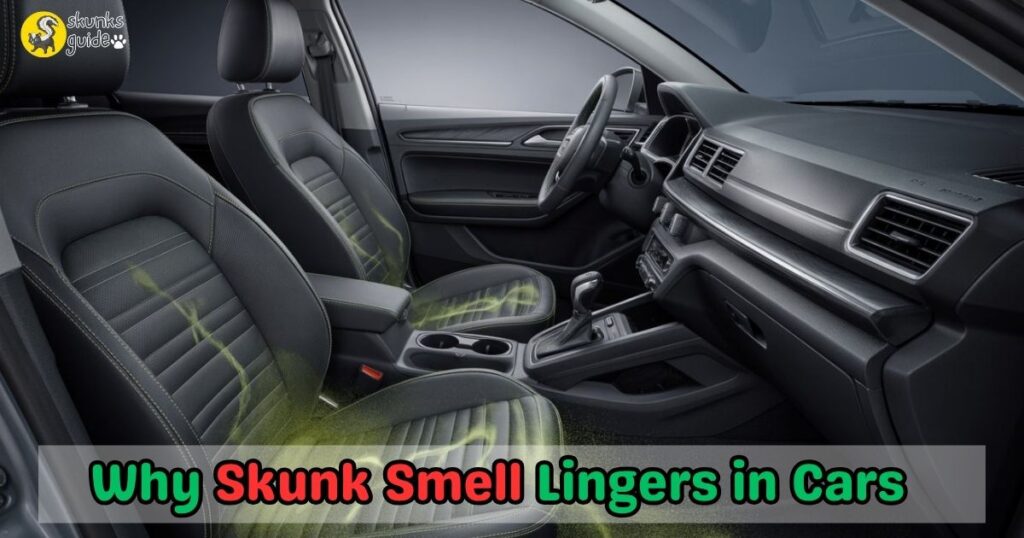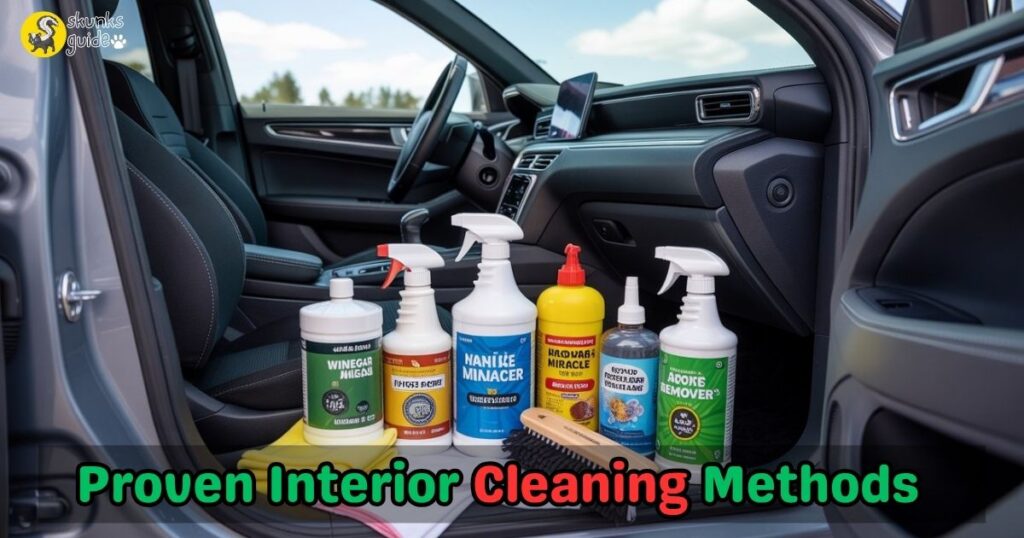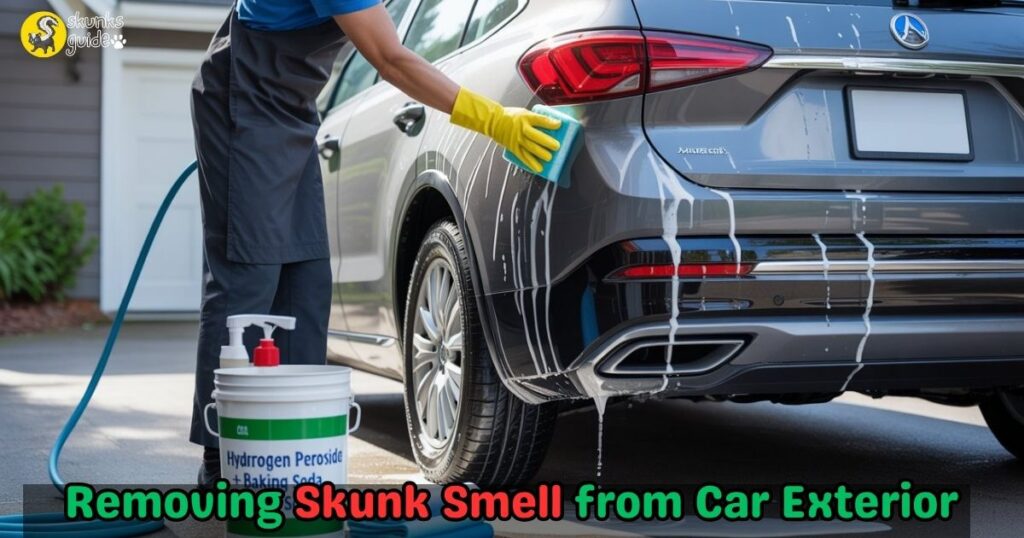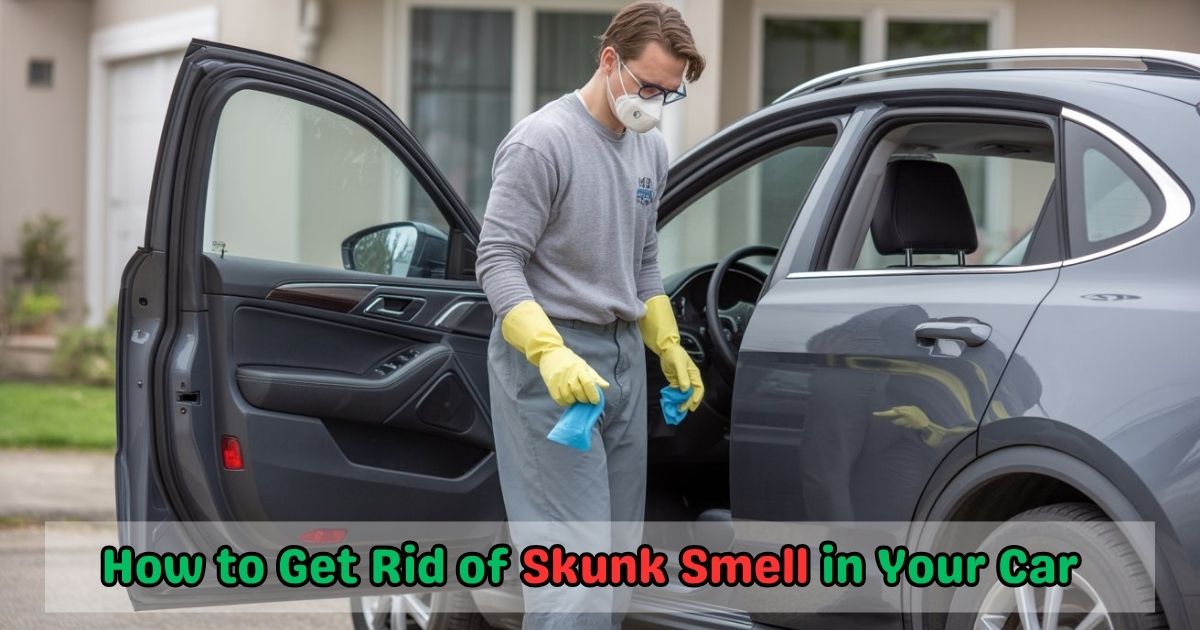How to Get Rid of Skunk Smell in Your Car
Getting sprayed by a skunk—or even just having your car nearby when it happens—can leave your vehicle smelling awful for days or even weeks. That strong, musky odor sticks to everything: the seats, carpets, vents, and even the outside paint. As someone who’s helped many people deal with this exact problem, I’ve put together a simple, step-by-step guide to help you remove the smell using things you probably already have at home, as well as some store-bought options that really work. Whether the skunk smell is inside your car or on the outside, don’t worry—we’ve got all the tips you need. Keep reading to learn exactly what to do and how to get your car smelling fresh again.
Why Skunk Smell Lingers in Cars

Skunk spray contains sulfur compounds—mainly thiols and thioacetates—that are incredibly volatile and can cling to porous materials (like fabrics, rubber, and plastic) for up to several weeks if not treated properly. Even a light whiff of that oily oil can cause tears and nausea, so prompt action is key. Plus, your car’s air vents and cabin air filter can circulate the smell long after first contact, making the interior unbearable. Understanding the nature of skunk odor helps explain why certain cleaning methods work (and why others fail).
Immediate Steps After a Skunk Encounter
Safety First: Ventilate and Protect
- Open All Doors & Windows: Before touching anything, crank down all windows and open all doors. Let fresh air blow through the cabin for at least 10–15 minutes to remove the most pungent vapors.
- Wear Protective Gear: Use disposable gloves (nitrile or latex) to avoid transferring spray onto your hands. Put on a mask (an N95 respirator is ideal) if you’re especially sensitive to sulfur odors.
Assess the Contamination
- Visual Check (Exterior): Look for visible spray residue on door handles, mirrors, bumpers, or the hood. Skunk oil often appears as a black, greasy smudge.
- Interior Check: Smell-test the seats, floor mats, headliner, and cabin vents. Identify whether the spray seeped inside through an open window, into the door jamb, or via gaps in weather stripping.
- HVAC Warning: If you smell skunk when the A/C or heater runs, the spray likely settled in the ductwork or filter. You’ll need to treat vents separately.
Proven Interior Cleaning Methods

Method 1: Vinegar + Baking Soda Solution
Why it works: White vinegar is acidic (pH ~2.5), which helps break down sulfur-based thiols. Baking soda (sodium bicarbonate) neutralizes odors by trapping acidic molecules in its crystals.
Materials Needed
- White distilled vinegar (1 gallon)
- Baking soda (½ cup)
- Warm water (2 gallons)
- Spray bottle
- Soft-bristled brush or microfiber cloths
Step-by-Step
- Prepare the Solution: In a large bucket, mix 1 cup of white vinegar into 2 gallons of warm water. Stir in ½ cup of baking soda—expect some fizzing.
- Vacuum First: Thoroughly vacuum seats, floor mats, and carpets to remove loose dirt and debris.
- Spray & Blot Upholstery: Transfer the solution to a spray bottle. Lightly mist the spray over fabric seats and carpeted areas; do not soak. Let sit for 5–10 minutes.
- Scrub Gently: Use a soft-bristled brush or clean microfiber cloth to gently scrub areas where the odor is strongest. You don’t need to scrub vigorously—light agitation helps the solution penetrate fibers.
- Blot Excess Moisture: Use a dry microfiber cloth to blot away as much moisture as possible.
- Air-Dry with Fan: Park in a sunny, breezy spot (if possible) or leave all doors open with a portable fan blowing across the seats. Allow at least 3–4 hours of drying time.
- Repeat if Needed: If the odor persists after 24 hours, repeat steps 1–6. Baking soda powder lightly sprinkled on seats overnight (then vacuumed) can absorb lingering smells.
Pro Tip: Always test an inconspicuous area (e.g., under the seat) first to ensure the vinegar solution doesn’t discolor or damage your upholstery.
Method 2: Enzymatic Cleaners & Odor Neutralizers
Why it works: Enzymes specifically break down organic compounds (including sulfur-based molecules) at a molecular level, eliminating odor sources rather than masking them.
Recommended Products
- Nature’s Miracle® Odor Remover: Designed for pet and wildlife odors; contains natural enzymes to break down thiols.
- Simple Solution® Extreme Pet Stain & Odor Remover: Heavy-duty enzymatic formula that works on car fabrics and floor mats.
- Green Gobbler® Skunk Odor Eliminator: Commercial-grade spray targeting skunk thiols.
Step-by-Step
- Locate Affected Zones: Identify seat cushions, carpet patches, or vent openings with strongest odor.
- Apply Enzymatic Spray: Following the product label, generously spray the solution on contaminated areas. Allow the cleaner to soak in (often 10–15 minutes).
- Agitate & Blot: Lightly agitate with a soft brush, then blot up excess.
- Let Enzymes Work: For best results, allow the product to sit for at least 6–8 hours (some recommend overnight) so enzymes have time to break down odor compounds.
- Vacuum or Wipe Up Residue: Once dry, vacuum any remaining dry residue or wipe with a clean cloth.
Tip: For HVAC vents, remove the cabin air filter (refer to your vehicle’s manual), spray an enzymatic cleaner into the vent ducts (use a straw extension if included), and let sit before running the fan to circulate fresh air. Replace the filter afterward.
Method 3: Activated Charcoal & Odor-Absorbing Products
Why it works: Activated charcoal has a highly porous structure that traps volatile odor molecules (including skunk thiols) without introducing chemicals.
Materials Needed
- Small activated charcoal bags or pouches (available online or at pet stores)
- Odor-absorbing gel packs (e.g., Arm & Hammer® Car Vent Clips with charcoal)
- Cabin air filter replacement (if heavily contaminated)
Step-by-Step
- Distribute Charcoal Bags: Place several small charcoal bags under seats, in cup holders, and in the glove box. For a larger cabin, use 3–4 small pouches spaced out evenly.
- Replace Cabin Air Filter: If your AC/heater still smells like skunk after 24 hours of airing out, replace the air filter. Insert an odor-absorbing vent clip (charcoal-based) behind the glove box or near the fan intake.
- Leave Overnight: Close all doors and leave the charcoal bags in place at least overnight (8–12 hours). In extreme cases, leave them for 2–3 days.
- Check & Replace: Charcoal bags typically work for 30–45 days. Replace if you notice diminishing odor absorption.
Note: Activated charcoal won’t remove all the smell instantly; it’s a slow-acting absorber that works in tandem with cleaning.
Removing Skunk Smell from Car Exterior

Exterior Rinse & Soap Wash
- Rinse Off Fresh Spray: Immediately spray the affected exterior panels (doors, bumpers, mirrors) with a high-pressure hose to remove oily residue.
- Use a High-pH Automotive Soap: If you have specialized car-degreasing soap (pH 9–10), mix according to instructions. Otherwise, use standard car wash shampoo.
- Scrub Gently: With a soft sponge or microfiber mitt, wash the areas in straight lines (avoid circular motions that can swirl scratches).
- Rinse Thoroughly: Rinse off all soap to avoid water spots; let the sun or a blower dry the paint.
DIY Skunk Spray Neutralizer Recipe
Why it works: A popular homemade formula uses hydrogen peroxide and baking soda to chemically alter thiols, transforming them into odorless compounds.
Ingredients
- 1 quart (32 oz) 3% hydrogen peroxide (not stabilized)
- ¼ cup baking soda
- 1 teaspoon liquid dish soap (dawn works well)
Warning: This mixture can foam vigorously. Never store it in a closed container; mix fresh and use immediately. Do not use on unpainted plastic, rubber trim, or tinted windows (peroxide may bleach).
Step-by-Step
- Prepare Outdoors: Mix peroxide, baking soda, and dish soap in a plastic bucket—stir slowly to avoid overflow.
- Apply Quickly: Using a garden sprayer or large spray bottle, mist the solution over affected areas. Work in small sections to prevent drying too fast.
- Let Sit 5–10 Minutes: Allow the chemical reaction to neutralize skunk thiols. Do not let it dry completely; re-spray if needed.
- Rinse Thoroughly: Use a powerful hose or pressure washer to rinse all solution off.
- Follow with Car Wash: After rinsing, follow up with a mild car soap wash and another final rinse to remove any residue.
Tip: Always test on a hidden area first (e.g., underside of the hood) to ensure paint compatibility.
Professional Exterior Detail Options
- Detailing Shops with Ozone Treatment: Some detailers use ozone generators inside a sealed car. Ozone (O₃) oxidizes odor molecules. A 30–60 minute session in an ozone chamber can significantly reduce or eliminate skunk odor.
- Steam Cleaning & Clay Bar Treatment: High-heat steam can lift oily residue from paint and trim. A clay bar can then remove fine contaminants. Finish with a quality wax sealant to lock out future odors.
- Professional Deodorizing Coatings: Certain aerosol or spray-on industrial deodorants bond with odor molecules. Ask your detailer to apply an automotive-safe odor binder if home remedies fail.
Related Information Table: Products & Methods Comparison
| Product/Method | Effectiveness | Best Use Case | Notes |
|---|---|---|---|
| Vinegar + Baking Soda | ★★★★☆ | Fabric seats, carpets, floor mats | Inexpensive; may require multiple applications for heavy odors. Test for colorfastness. |
| Enzymatic Cleaners | ★★★★★ | Upholstery, carpets, HVAC vents | Breaks down odor at molecular level; needs dwell time (6–8 hrs). |
| Activated Charcoal Bags | ★★★☆☆ | Slow, steady odor absorption—in cabin spaces | Best used after initial cleaning; works over days/weeks. |
| DIY Peroxide + Baking Soda | ★★★★☆ | Exterior paint, bumpers, metal trim | Can lighten dark plastic or trim; rinse quickly and carefully. |
| Professional Ozone Treatment | ★★★★★ | Interior HVAC vents, headliner, deep fabrics | Can be costly ($50–$150); must follow safety guidelines (no humans in car). |
| Steam Cleaning & Clay Bar | ★★★★☆ | Exterior paint, trim, windows | Effective for removing oily residue; often combined with wax. |
| Commercial Odor Neutralizer | ★★★★☆ | Entire cabin (quick fix) | May mask smell temporarily; choose enzyme-based for lasting results. |
Preventing Future Skunk Odor Issues
- Park Strategically: Avoid parking near trash cans, brush piles, or other skunk habitats—especially at dawn/dusk when skunks are most active.
- Illuminate Driveway/Yard: Installing motion-sensor lights or LED floodlights can deter nocturnal skunks from approaching.
- Use Skunk Deterrent Sprays: Commercial predator urine sprays (coyote or fox) can discourage skunks from coming near vehicles. Reapply monthly.
- Regular Interior Maintenance: Clean floor mats and vacuum the cabin weekly. Wipe down door jambs to spot early spray residue.
- Replace Cabin Air Filter Annually: A fresh filter traps odor particles before they circulate. Consider a HEPA-grade filter if your vehicle supports it.
Frequently Asked Questions (FAQs)
Skunk odor can linger for 7–14 days (or longer) on untreated surfaces. In hot, sunny conditions, the smell may dissipate faster (around 5–7 days), whereas in cooler or humid climates, it can last 2–3 weeks. Regular driving and mild cleaning (soap + water) can reduce this timeframe somewhat, but deep-set odors in carpets or vents require thorough cleaning.
No—masking agents only temporarily cover up the odor and may mix unpleasantly with skunk thiols. Instead, focus on neutralizing (via vinegar, enzymatic cleaners, or charcoal) rather than covering it. Once the source is gone, you can add a light citrus or pine-scented air freshener as a finishing touch.
Yes, it’s generally safe to drive if the spray didn’t hit mechanical components (like the engine bay). However, you may experience temporary nausea or watery eyes. Ventilate by rolling down windows and turning on ventilated fresh air mode. Avoid recirculation mode, which will pull odor back into the cabin.
Skunk oil can seep into ductwork and the cabin air filter. Remove and replace the filter, then spray an enzymatic cleaner into the air ducts. Run the fan on high for 10–15 minutes (windows open). If smell persists, consider a professional ozone treatment to oxidize remaining thiols.
Yes. Applying a quality paint sealant or wax creates a protective barrier that repels oil-based contaminants (including skunk spray). If a skunk sprays again, most residue will rest on the waxed surface and rinse off more easily. Re-wax every 3–4 months for best protection.
For leather, skip the vinegar solution. Instead: Wipe with a damp microfiber cloth (water only) to remove surface spray.
Apply a pH-neutral leather cleaner (labeled safe for leather) in small amounts.
Wipe off with a clean cloth and let air-dry.
Use a leather conditioner afterward to restore natural oils.

